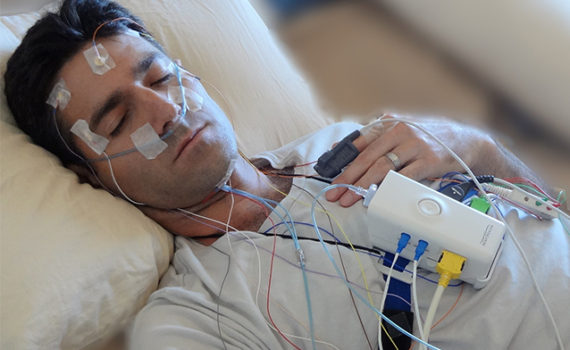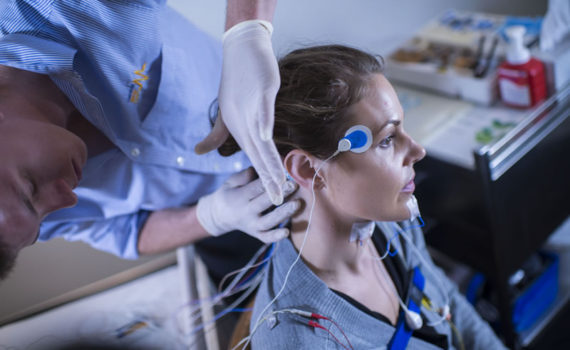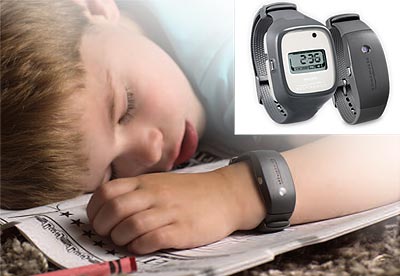Sleep Study .. To study your sleep we need to monitor and observe some of the physiological changes during sleep.
A sleep study or polysomnogram can help to discover the causes of sleep disorders and plan your treatment. We do the sleep study during your normal sleeping hours.

Home Sleep Testing
Home sleep testing is where the patient will take a simple sleep monitor equipment from the center. You will usually set up the testing equipment yourself before going to sleep and bring it back the day after. It allows you to sleep at home wearing equipment that collects information about how you breathe during sleep.
There is a variety of home sleep apnea testing devices. These devices measure your breathing, heart rate and blood oxygen level.
Home sleep apnea testing is used to diagnose obstructive sleep apnea. A physician may recommend home sleep apnea testing if:
- It is highly likely that you have moderate to severe obstructive sleep apnea.
- You have no significant medical conditions other than the suspected obstructive sleep apnea.

Polysomnography (PSG)
Overnight Sleep Test Polysomnography (PSG)
Polysomnogram is an overnight sleep study in the sleep center. There will not be any other patients in your room. You will have a bathroom available to use.
A trained sleep technician will prepare you for the test and apply sensors to the head, face, chest, abdomen, and legs. None of these devices hurt, then he will monitor the physiological indicators during sleep including brain waves, heart rate, breathing rate, oxygen level, eye movements, and chin movements.
When it is time for you to try to go to sleep, the lights will go off and a low-light video camera will allow the technologist to see you from a nearby room. If a sensor comes loose or you need to go to the bathroom during the night, the technologist will have to help you with the wires.
Nearly everyone falls asleep during an in-lab study. In most cases, you do not need a full eight hours of sleep for the doctor to make a diagnosis.
On the day of your in-lab sleep study, you should:
- Try to follow your regular routine as much as possible.
- Avoid napping.
- Eliminate use of caffeine after lunch.
- Shower or avoid using hair sprays or gels that can interfere with the sleep recording.
- If you are on a regular medication, speak with your sleep medicine physician.
- Bring any items that you need for your nightly routine. Prepare for the sleep study as if you are staying at a hotel for a night. You may want to bring: comfortable pajamas or clothes to sleep in, a toothbrush, toothpaste, and dental floss.

Multiple Sleep Latency Test (MSLT)
MSLT will measure how quickly you fall asleep in a quiet environment during the day. Also known as a daytime nap study. The MSLT is the standard tool used to diagnose narcolepsy and idiopathic hypersomnia. The MSLT is a full-day test that consists of five scheduled naps separated by two-hour breaks. During each nap trial, you will lie in bed to try to sleep. Once the lights go off, the test will measure how long it takes you to fall asleep. You will be awakened after sleeping 15 minutes. If you do not fall asleep within 20 minutes, the nap trial will end.
The night before your MSLT, you will have an overnight sleep study. For the MSLT to be accurate, you will need to sleep at least six hours during the overnight sleep study. An overnight sleep study can determine if another sleep disorder such as obstructive sleep apnea is causing your excessive daytime sleepiness.
You will take your first scheduled nap an hour-and-a-half to three hours after you wake up from the overnight sleep study. About an hour before your first nap trial, you will eat a light breakfast.

Multiple Wakefulness Test (MWT)
MWT is used to measure how alert you are during the day. It shows whether you are able to stay awake for a defined period. This is an indicator of how well you are able to function and remain alert in quiet times of inactivity.
The test is based on the idea that your ability to stay awake may be more important to know in some cases than how fast you fall asleep. This is the case when the MWT is used to see how well a sleep disorders patient is able to stay awake after starting treatment. It is also used to help judge whether a patient is too tired to drive or perform other daily tasks.
MWT consists of four sleep trials with breaks lasting for two hours in between them. For each trial, you will sit quietly in bed with your back and head supported by a pillow. It is important that you are as comfortable as you can be. You will be asked to sit still and look directly ahead of you. Then you simply try to stay awake for as long as you can. You are not allowed to do other things to try to keep yourself awake. This includes actions such as singing or slapping your face. All sunlight will be kept out of your room.
If you fall asleep, then you will be awakened after sleeping for only about 90 seconds. The test will end if you do not fall asleep within 40 minutes.

Actigraphy
it is now possible to measure a person’s activity, environmental temperature, and light levels, all by a device like a wristwatch. We use Actigraphy in the assessment of patients with Insomnia Circadian Rhythm Disorders or other sleep disorder.
What Happens After the Test?
All monitoring devises will be removed, within few days you have to come to sleep Disorders Clinic for your follow up appointment with your Physician. By that time, the sleep study results will be thoroughly analyzed, scored, and interpreted by the sleep consultant. Your Physician will explain the test results to you and he will discuss with you the treatment options.